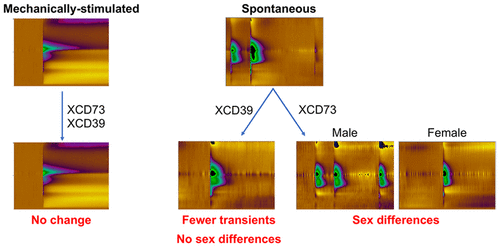当前位置:
X-MOL 学术
›
ACS Chem. Neurosci.
›
论文详情
Our official English website, www.x-mol.net, welcomes your
feedback! (Note: you will need to create a separate account there.)
CD73 or CD39 Deletion Reveals Different Mechanisms of Formation for Spontaneous and Mechanically Stimulated Adenosine and Sex Specific Compensations in ATP Degradation.
ACS Chemical Neuroscience ( IF 4.1 ) Pub Date : 2020-03-04 , DOI: 10.1021/acschemneuro.9b00620 Ying Wang 1 , Jeffrey Copeland 1, 2 , Mimi Shin 1 , Yuanyu Chang 1 , B Jill Venton 1
ACS Chemical Neuroscience ( IF 4.1 ) Pub Date : 2020-03-04 , DOI: 10.1021/acschemneuro.9b00620 Ying Wang 1 , Jeffrey Copeland 1, 2 , Mimi Shin 1 , Yuanyu Chang 1 , B Jill Venton 1
Affiliation

|
Adenosine is important for local neuromodulation, and rapid adenosine signaling can occur spontaneously or after mechanical stimulation, but little is known about how adenosine is formed in the extracellular space for those stimulations. Here, we studied mechanically stimulated and spontaneous adenosine to determine if rapid adenosine is formed by extracellular breakdown of adenosine triphosphate (ATP) using mice globally deficient in extracellular breakdown enzymes, either CD39 (nucleoside triphosphate diphosphohydrolase 1, NTPDase1) or CD73 (ecto-5'-nucleotidase). CD39 knockout (KO) mice have a lower frequency of spontaneous adenosine events than wild-type (WT, C57BL/6). Surprisingly, CD73KO mice demonstrate sex differences in spontaneous adenosine; males maintain similar event frequencies as WT, but females have significantly fewer events and lower concentrations. Examining the mRNA expression of other enzymes that metabolize ATP revealed tissue nonspecific alkaline phosphatase (TNAP) was upregulated in male CD73KO mice, but not secreted prostatic acid phosphatase (PAP) or transmembrane PAP. Thus, TNAP upregulation compensates for CD73 loss in males but not in females. These sex differences highlight that spontaneous adenosine is formed by metabolism of extracellular ATP by many enzymes. For mechanically stimulated adenosine, CD39KO or CD73KO did not change stimulation frequency, concentration, or t1/2. Thus, the mechanism of formation for mechanically stimulated adenosine is likely direct release of adenosine, different than spontaneous adenosine. Understanding these different mechanisms of rapid adenosine formation will help to develop pharmacological treatments that differentially target modes of rapid adenosine signaling, and all treatments should be studied in both sexes, given possible differences in extracellular ATP degradation.
中文翻译:

CD73或CD39删除揭示了自发和机械刺激的腺苷形成的不同机制以及ATP降解中的性别特异性补偿。
腺苷对于局部神经调节很重要,快速的腺苷信号可以自发发生或在机械刺激后发生,但对于这些刺激在细胞外空间中如何形成腺苷知之甚少。在这里,我们研究了机械刺激的和自发的腺苷,以确定是否使用胞外分解酶(CD39(三磷酸核苷二磷酸二氢水解酶1,NTPDase1)或CD73(ecto-5)缺陷的小鼠)通过腺苷三磷酸(ATP)的胞外分解来形成快速腺苷。 '-核苷酸酶)。CD39基因敲除(KO)小鼠的自发性腺苷事件发生率低于野生型(WT,C57BL / 6)。令人惊讶的是,CD73KO小鼠表现出自发性腺苷的性别差异。男性维持与野生动植物相似的事件发生频率,但是雌性事件少得多,集中度也低。检查其他代谢ATP的酶的mRNA表达,发现在雄性CD73KO小鼠中组织非特异性碱性磷酸酶(TNAP)上调,但未分泌前列腺酸性磷酸酶(PAP)或跨膜PAP。因此,TNAP上调补偿了男性的CD73损失,而女性没有。这些性别差异突出表明,自发性腺苷是由许多酶代谢细胞外ATP形成的。对于机械刺激的腺苷,CD39KO或CD73KO不会改变刺激频率,浓度或t1 / 2。因此,与自发性腺苷不同,机械刺激的腺苷的形成机制可能是腺苷的直接释放。
更新日期:2020-03-04
中文翻译:

CD73或CD39删除揭示了自发和机械刺激的腺苷形成的不同机制以及ATP降解中的性别特异性补偿。
腺苷对于局部神经调节很重要,快速的腺苷信号可以自发发生或在机械刺激后发生,但对于这些刺激在细胞外空间中如何形成腺苷知之甚少。在这里,我们研究了机械刺激的和自发的腺苷,以确定是否使用胞外分解酶(CD39(三磷酸核苷二磷酸二氢水解酶1,NTPDase1)或CD73(ecto-5)缺陷的小鼠)通过腺苷三磷酸(ATP)的胞外分解来形成快速腺苷。 '-核苷酸酶)。CD39基因敲除(KO)小鼠的自发性腺苷事件发生率低于野生型(WT,C57BL / 6)。令人惊讶的是,CD73KO小鼠表现出自发性腺苷的性别差异。男性维持与野生动植物相似的事件发生频率,但是雌性事件少得多,集中度也低。检查其他代谢ATP的酶的mRNA表达,发现在雄性CD73KO小鼠中组织非特异性碱性磷酸酶(TNAP)上调,但未分泌前列腺酸性磷酸酶(PAP)或跨膜PAP。因此,TNAP上调补偿了男性的CD73损失,而女性没有。这些性别差异突出表明,自发性腺苷是由许多酶代谢细胞外ATP形成的。对于机械刺激的腺苷,CD39KO或CD73KO不会改变刺激频率,浓度或t1 / 2。因此,与自发性腺苷不同,机械刺激的腺苷的形成机制可能是腺苷的直接释放。











































 京公网安备 11010802027423号
京公网安备 11010802027423号